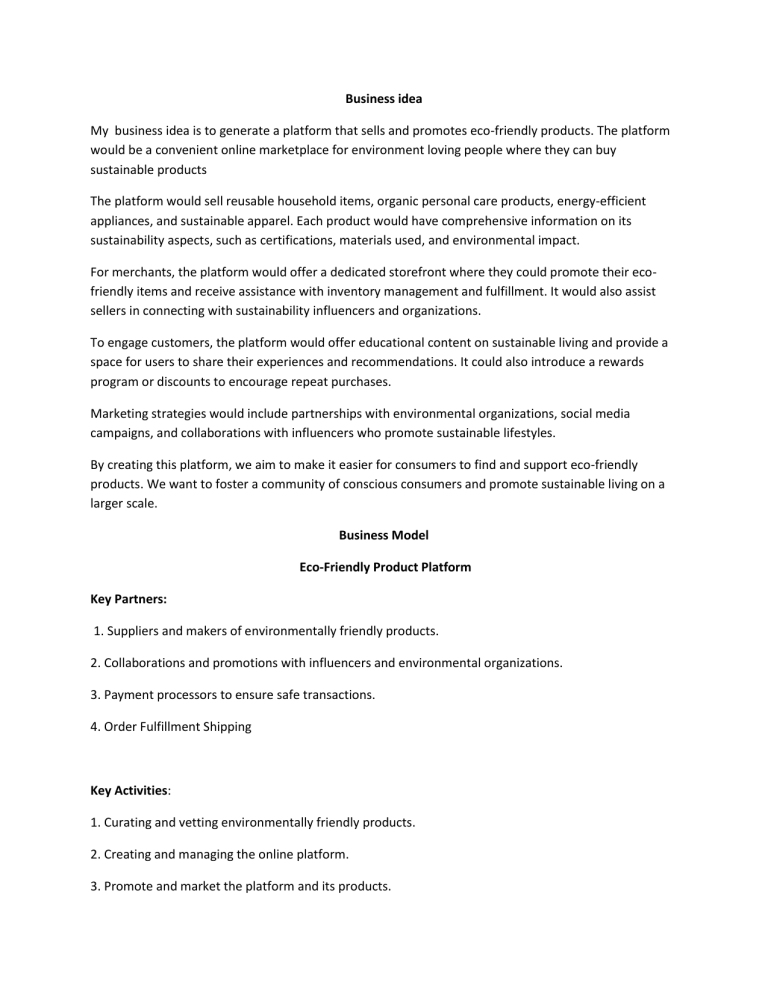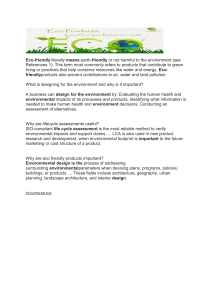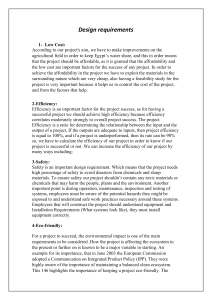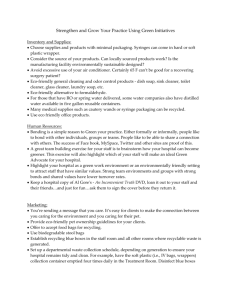
Business idea My business idea is to generate a platform that sells and promotes eco-friendly products. The platform would be a convenient online marketplace for environment loving people where they can buy sustainable products The platform would sell reusable household items, organic personal care products, energy-efficient appliances, and sustainable apparel. Each product would have comprehensive information on its sustainability aspects, such as certifications, materials used, and environmental impact. For merchants, the platform would offer a dedicated storefront where they could promote their ecofriendly items and receive assistance with inventory management and fulfillment. It would also assist sellers in connecting with sustainability influencers and organizations. To engage customers, the platform would offer educational content on sustainable living and provide a space for users to share their experiences and recommendations. It could also introduce a rewards program or discounts to encourage repeat purchases. Marketing strategies would include partnerships with environmental organizations, social media campaigns, and collaborations with influencers who promote sustainable lifestyles. By creating this platform, we aim to make it easier for consumers to find and support eco-friendly products. We want to foster a community of conscious consumers and promote sustainable living on a larger scale. Business Model Eco-Friendly Product Platform Key Partners: 1. Suppliers and makers of environmentally friendly products. 2. Collaborations and promotions with influencers and environmental organizations. 3. Payment processors to ensure safe transactions. 4. Order Fulfillment Shipping Key Activities: 1. Curating and vetting environmentally friendly products. 2. Creating and managing the online platform. 3. Promote and market the platform and its products. 4. Managing seller relationships and providing customer service. 5. Researching long-term trends and customer preferences. Key Resources 1. Online platforms and websites. 2. Product catalog and inventory management system. 3. Sustainable product expertise and experienced team. 4. Marketing Channels 5. Customer support team. 6. Convenient business network and partnerships. Value Proposition 1. Convenient access to a wide range of eco-friendly products. 2. Detailed sustainability information for each product. 3. Trusted platform with vetted products and sellers. 4. Educational resources for sustainable living. 5. Opportunities for sellers to showcase and promote their eco-friendly products. Customer Segments 1. Eco-conscious consumers seeking sustainable products. 2. Businesses looking for environmentally friendly supplies. 3. Sustainable lifestyle enthusiasts. 4. Influencers and organizations promoting eco-friendly living. Customer Relationships 1. User-friendly online platform for easy browsing and purchasing. 2. Prompt customer support for inquiries and issues. 3. Engaging content and educational resources. 4. Personalized recommendations based on customer preferences. Channels 1. Online platform accessible via website and mobile app. 2. Social media platforms for marketing and promotions. 3. Collaborations with influencers and sustainability organizations. 4. Email marketing and newsletters. Revenue Streams 1. Commission or transaction fees from product sales. 2. Advertising and sponsored content. 3. Premium features or subscriptions for sellers. Cost Structure 1. Platform development and maintenance costs. 2. Employee salaries and benefits. 3. Marketing and advertising expenses. 4. Inventory and fulfillment costs. 5. Technology infrastructure and hosting fees. This business model aims to generate revenue by connecting eco-conscious customers with sustainable products while providing a user-friendly platform for sellers to showcase their offerings. The focus on educational resources and partnerships helps build a community around sustainable living, fostering customer loyalty and engagement. Business Strategy The platform will set itself apart by offering comprehensive information and a wide selection of premium eco-friendly products. The platform will draw eco-conscious customers looking for dependable and convenient shopping experiences by providing a wide variety of vetted products. User Experience: A seamless and user-friendly online platform will be prioritized. The mobile app and website will have easy-to-use navigation, comprehensive search capabilities, and precise product information. The user experience will be improved overall by personalized recommendations and educational resources. Collaborations and Partnerships: In order to expand its influence and advance sustainable living, the platform will form partnerships with businesses, sustainability organizations, and influencers. Co- branded campaigns, exclusive product launches, and joint marketing initiatives are some examples of collaborations that can be used to build brand awareness and draw in a larger customer base. Competitive Strategy 1. Extensive Product Catalog By offering a wide range of eco-friendly products of various categories, the platform will differentiate itself from competitors with limited selections. This breadth of offerings will cater to diverse customer preferences and needs, providing a onestop-shop for sustainable products. 2. Reliability and Trust The platform's strong emphasis on curating and vetting products for their sustainability credentials will instill trust and confidence in customers This focus on quality assurance will set the platform apart from other marketplaces where ecofriendly claims may be less reliable. 3. Education and Community Building The inclusion of educational resources and community engagement features will set the platform apart as a destination for sustainable living beyond just product sales. By fostering a sense of community and empowering customers with knowledge, the platform will deepen customer loyalty and differentiate itself from competitors solely focused on transactions. 4. Seller Support The platform will provide comprehensive support for sellers, including marketing tools, inventory management assistance, and access to a network of sustainability-minded influencers. This support will attract sellers who want to showcase their eco-friendly products and create a thriving ecosystem on the platform. 5. Customer Support and Satisfaction Strong customer support, prompt response to inquiries, and efficient order fulfillment will be key priorities. By ensuring exceptional customer experiences, the platform will generate positive word-of-mouth and build customer loyalty, giving it a competitive advantage in the market. Overall, the business strategy focuses on differentiation through product cu ration, user experience, partnerships, and community-building. These strategies, coupled with a competitive edge in product selection, trust, education, and support, will position the platform as a leader in the promotion and sale of eco-friendly products. 1) Market Strategy 2) Marketing that is specifically aimed at certain customer groups, such as those who are environmentally conscious consumers, fans of sustainable lifestyles, or companies looking for eco-friendly supplies. Adapt marketing strategies and channels to effectively reach these audiences. 3) Develop a compelling brand identity that communicates the platform's dedication to sustainability and environmental friendliness. Focus on the platform's ease of use, reliability, and educational features. To strengthen the brand image, use consistent messaging across marketing materials, social media, and website content. 4) Collaborations with Influencers: Work together with sustainability activists and influencers who share the platform's values. Promote the platform and its products by working with influencers to create sponsored content, solicit product reviews, and host giveaways. Utilize their influence and reputation to raise brand awareness and draw in new clients. 5) Content marketing: Produce interesting and educational content about eco-friendly behaviors, sustainable living, and product highlights. Create a blog or resources section on the platform's website to disseminate articles, how-tos, and other information. Utilize social media channels to share content and interact with the intended audience. 6) Partnerships with Environmental Organizations: To increase credibility and reach, form alliances with regional and international environmental organizations. Work together on initiatives, campaigns, or events that support the platform's mission. Customers who care about the environment may become aware of this, and it may also benefit from these organizations' networks and influence. 7) Implement a customer referral program to persuade current users to spread the word about the platform to their networks. Provide rewards or discounts as incentives for successful referrals. Utilize word-of-mouth advertising to grow your customer base naturally. 8) Encourage customers to share reviews and testimonials about their interactions with the platform and its products. To increase trust and social proof, prominently display these reviews on the website and incorporate them into marketing materials. By implementing these market strategies, the platform will increase brand awareness, attract a loyal customer base, and establish itself as a go-to destination for eco-friendly products. Growth Strategy ● Geographic Expansion: Identify new regions or countries where there is a demand for ecofriendly products and expand the platform's presence into these markets. Conduct market research to understand local preferences, regulations, and competition. ● Diversification of Product Offerings: Continuously assess customer needs and market trends to expand the range of eco-friendly products available on the platform. Introduce new categories or collaborate with sustainable brands to offer innovative and in-demand products. ● Enhanced Customer Engagement: Implement strategies to deepen customer engagement and increase customer lifetime value. This can include loyalty programs, personalized recommendations, and exclusive offers for repeat customers. ● Strategic Partnerships: Form strategic partnerships with complementary businesses or platforms to expand the customer base and increase brand exposure. Collaborate with sustainable lifestyle brands, eco-friendly service providers, or other platforms to cross-promote products and services. ● Mobile App Development: Develop a mobile app to provide a seamless and convenient shopping experience for customers on-the-go. Utilize push notifications, personalized offers, and locationbased features to enhance customer engagement and increase sales. ● User-generated Content: Encourage customers to share their experiences, reviews, and photos of products on social media platforms. Leverage user-generated content to build brand advocacy, attract new customers, and create a sense of community around the platform. ● Data-driven Insights: Utilize data analytics to gain insights into customer behavior, preferences, and purchase patterns. Leverage these insights to optimize marketing campaigns, identify growth opportunities, and improve the overall customer experience. ● International Partnerships: Collaborate with international sustainability organizations, brands, or marketplaces to expand the platform's reach globally. Establish partnerships that allow for cross-border sales, distribution, and marketing to tap into new markets. ● Continuous Innovation: Stay updated with emerging sustainability trends, technological advancements, and consumer demands. Regularly introduce new features, tools, or services that add value to the platform and differentiate it from competitors. ● Mergers and Acquisitions: Evaluate opportunities for strategic mergers or acquisitions that can accelerate growth, access new markets, or acquire specialized technology or expertise in the eco-friendly product industry. By implementing these growth strategies, the platform can increase its market share, attract new customers, and solidify its position as a leading platform for eco-friendly products. Marketing and Sales approach strategies 1. Digital Advertising: Utilize targeted online advertising campaigns on platforms such as Google Ads and social media channels. Tailor advertisements to reach specific customer segments effectively. 2. Social Media Marketing: Engage with the target audience through social media platforms. Create visually appealing content, run contests or giveaways, collaborate with relevant influencers, and actively interact with customers. 3. Search Engine Optimization (SEO): Optimize the platform's website and product pages to improve organic search rankings. Develop high-quality content, establish backlinks, and ensure a user-friendly website structure. 4. Content Marketing: Implement a content strategy focused on educating customers about sustainable living and eco-friendly practices. Produce engaging blog posts, videos, and infographics to attract and retain customers. 5. Email Marketing: Build an email list and send targeted campaigns to nurture customer relationships. Personalize recommendations, share exclusive offers, and provide informative newsletters. 6. Influencer Marketing: Collaborate with influencers and sustainability advocates to promote the platform. Encourage them to review products, create sponsored content, and share their experiences with their followers. 7. Referral Programs: Implement a referral program to incentivize existing customers to refer new customers. Offer rewards or exclusive benefits for successful referrals. 8. Partnerships with Sustainable Brands and Organizations: Collaborate with compatible sustainable brands or organizations for joint marketing campaigns or cross-promotion. Leverage their customer base and credibility. 9. Remarketing and Retargeting: Re-engage potential customers who have shown interest but have not made a purchase. Utilize display ads and personalized offers to encourage them to return. 10. Customer Relationship Management (CRM): Utilize a CRM system to manage customer data, track interactions, and personalize communications. Tailor marketing messages and recommend relevant products. 11. Sales and Promotions: Run periodic sales, promotions, or limited-time offers to drive sales. Highlight the value and benefits of eco-friendly products to incentivize purchases. 12. Customer Reviews and Testimonials: Encourage customers to provide reviews and testimonials. Display them prominently to build trust and influence potential customers. 13. Trade Shows and Events: Participate in relevant trade shows or events focused on sustainability. Showcase the platform's offerings and engage with potential customers. 14. Customer Support and Satisfaction: Provide efficient customer support through various channels. Address inquiries and concerns promptly to ensure a positive customer experience. 15. Data Analysis and Optimization: Monitor marketing campaigns, track key performance indicators (KPIs), and analyze customer data. Use data-driven insights to optimize targeting, messaging, and marketing channels. By implementing these marketing and sales approaches and strategies, the platform can effectively reach and engage the target audience, drive sales, and establish a strong brand presence in the ecofriendly product market. Recommendations to make Business Successful and profitable 1. Specialize and Differentiate: Focus on a specific niche within the eco-friendly product industry and differentiate the platform by offering unique and specialized products. This will help establish a strong value proposition and attract a loyal customer base. 2. Curate High-Quality Products: Implement rigorous product vetting processes to ensure that only high-quality eco-friendly products are featured on the platform. This will build trust with customers and enhance the platform's reputation. 3. Cultivate Strategic Partnerships: Collaborate with sustainable brands, influencers, and environmental organizations to expand reach and tap into existing networks. Joint marketing campaigns, partnerships, and exclusive offerings can help drive customer acquisition and increase brand visibility. 4. Educate and Engage Customers: Provide informative content, educational resources, and engaging social media campaigns to educate customers about sustainable living. Foster a sense of community by encouraging customer interaction and sharing of experiences and tips. 5. Enhance User Experience: Invest in user-friendly website design, intuitive navigation, and mobile responsiveness. Streamline the purchasing process, offer secure payment options, and provide detailed product information to create a seamless and satisfying user experience. 6. Implement Effective Marketing Strategies: Utilize a combination of targeted digital advertising, social media marketing, content marketing, and influencer collaborations to reach and engage the target audience effectively. Continuously analyze and optimize marketing efforts based on data insights. 7. Prioritize Customer Satisfaction: Deliver exceptional customer service, respond promptly to inquiries, and ensure efficient order fulfillment. Encourage and showcase customer reviews and testimonials to build trust and establish social proof. 8. Foster Innovation and Adaptation: Stay updated on emerging eco-friendly trends, technological advancements, and customer preferences. Continuously innovate and adapt the product offerings, explore new market opportunities, and stay ahead of the competition. 9. Monitor Key Metrics: Regularly track and analyze key performance indicators (KPIs) such as customer acquisition costs, conversion rates, and customer satisfaction. Use data insights to identify areas for improvement, optimize operations, and make informed business decisions. 10. Achieve Sustainable Profitability: Manage costs effectively, optimize operational efficiency, and strategically price products to achieve sustainable profitability. Continuously evaluate and refine the business model, revenue streams, and market dynamics. By implementing these recommendations, the business can establish itself as a successful and profitable platform in the eco-friendly product market. Differentiation, strategic partnerships, customer focus, innovation, and data-driven decision-making will be key drivers of success. Risks with this business Market competition: With numerous established and emerging players, the market for environmentally friendly products is becoming more and more competitive. Competing platforms or markets with comparable offerings could make it difficult to draw in and keep customers. To differentiate the platform from the competition and to constantly innovate, it is crucial. Consumer Education and Awareness: Although there may still be a need for consumer education and awareness regarding the significance and advantages of such products, the demand for eco-friendly goods is rising. It will be essential to address this issue through educational content and focused marketing campaigns in order to draw in and convert customers. Product quality and Supplier Reliability: It's crucial to have a dependable supply chain and to buy highquality eco-friendly products from reliable suppliers. There is a chance of running into suppliers who don't deliver consistently high-quality products or the desired sustainability standards. This risk can be reduced by putting in place strict supplier evaluation procedures and keeping solid connections with dependable suppliers. Pricing and Profitability: Setting competitive prices for eco-friendly products while preserving profitability can be difficult. Higher production costs for eco-friendly products can affect their profit margins. It is crucial to carry out in-depth market research and create pricing strategies that strike a balance between customer affordability and company profitability. Regulation and Compliance Requirements: The market for eco-friendly products is subject to a number of regulations and compliance standards, including certification requirements and labeling guidelines. To avoid legal problems and preserve customer trust, it is essential to stay informed and make sure that these regulations are being followed. Reputation and Trust: Long-term success in the eco-friendly community depends on establishing and upholding a solid reputation and level of trust. The platform's reputation could be harmed by bad customer experiences, product controversies, or environmental claims. This risk can be reduced by emphasizing customer satisfaction, openness, and moral business conduct. Technical difficulties: The platform's reliance on technology increases the risk of operational errors, cyber security threats, or data breaches. The platform will be safer and customer data will be more secure if substantial cyber security measures, routine system maintenance, and backup procedures are invested in. Economic and environmental factors: The demand for environmentally friendly products may be impacted by economic downturns or changes in consumer spending habits. Environmental factors can also have an impact on supply chains and the availability of specific products, such as natural disasters or events linked to climate change. These risks can be reduced by adjusting to such changes and diversifying product offerings. How to deal with the risks 1. Market Competition: ● Differentiate the platform by offering unique product selections, specialized services, or additional value-added features. ● Continuously monitor the market, stay updated on industry trends, and adapt the platform's offerings to meet evolving customer demands. ● Build strong relationships with suppliers and secure exclusive partnerships to offer unique products that competitors may not have access to. 2. Consumer Education and Awareness: ● Develop a robust content marketing strategy to educate and raise awareness about the benefits of eco-friendly products. ● Utilize social media platforms, blog articles, videos, and tutorials to provide informative and engaging content that empowers customers to make sustainable choices. ● Collaborate with influencers and sustainability experts to amplify the message and reach a wider audience. 3. Supplier Reliability and Product Quality: ● Implement thorough supplier evaluation processes to ensure they meet sustainability standards and maintain consistent product quality. ● Establish strong relationships with trusted suppliers and conduct regular audits or inspections to verify compliance. ● Stay updated on industry certifications and work with certified suppliers to enhance credibility and trust. 4. Pricing and Profitability: ● Conduct thorough market research to understand pricing trends and competitive landscape. ● Optimize operational efficiency to reduce costs without compromising on product quality. ● Offer value-added services or loyalty programs to differentiate from competitors and justify pricing. 5. Regulatory and Compliance Requirements: ● Stay informed about applicable regulations and ensure full compliance with labeling, certification, and environmental standards. ● Partner with certified suppliers and communicate the platform's commitment to regulatory compliance to build customer trust. ● Keep abreast of any changes in regulations and update product listings and information accordingly. 6. Reputation and Trust: ● Prioritize exceptional customer service and promptly address any customer concerns or issues. ● Establish a transparent communication channel to address inquiries, provide product information, and resolve disputes. ● Engage in ethical business practices, maintain transparency in product sourcing, and actively communicate the platform's sustainability mission. 7. Technological Challenges: ● Implement robust cybersecurity measures, including secure data storage, encryption, and regular system updates. ● Conduct periodic system audits and vulnerability assessments to identify and address potential weaknesses. ● Establish data backup protocols and disaster recovery plans to minimize disruptions in case of technical issues. 8. Economic and Environmental Factors: ● Diversify the product offerings to cater to a wider range of customer needs and mitigate risks associated with fluctuations in demand. ● Stay agile and responsive to economic and environmental changes by monitoring market conditions and adjusting strategies accordingly. ● Foster strong relationships with suppliers and maintain open communication to address any supply chain disruptions. By actively managing these risks, the business can enhance its resilience, maintain customer trust, and position itself for sustainable growth in the eco-friendly product market. Regular assessment, continuous improvement, and adaptability are key to addressing potential risks effectively. Product Offerings 1. Reusable Household Items: Discover a wide variety of reusable household products, including stainless steel water bottles, glass food storage containers, silicone food wraps, bamboo utensils, and eco-friendly cleaning supplies. These items are designed to help you reduce waste and embrace a more sustainable lifestyle. 2. Organic Personal Care Products: Explore our collection of organic and natural personal care items that prioritize your well-being and the environment. From shampoo bars and refillable beauty products to biodegradable toothbrushes and cruelty-free cosmetics, our range of options allows you to indulge in self-care while making eco-conscious choices. 3. Energy-Efficient Appliances: Upgrade your home with energy-efficient appliances that promote sustainability. Discover eco-friendly washing machines, low-energy refrigerators, smart thermostats, LED lighting solutions, and solar-powered gadgets that help you save energy and reduce your carbon footprint. 4. Sustainable Fashion and Accessories: Step into the world of sustainable fashion with our thoughtfully curated selection. Find organic clothing, ethically made footwear, upcycled accessories, eco-friendly jewelry, and vegan leather goods that combine style with social and environmental responsibility. 5. Eco-Friendly Packaging Solutions: Embrace sustainable packaging alternatives for your shipping and storage needs. Choose from compostable mailers, reusable shopping bags, biodegradable food containers, recyclable shipping materials, and zero-waste packaging solutions that minimize waste and support a greener future. 6. Green Home and Garden Products: Nurture your home and garden sustainably with our range of eco-friendly essentials. Explore organic gardening supplies, solar-powered outdoor lighting, rainwater harvesting systems, sustainable furniture, and natural home fragrances that bring eco-consciousness into your living space. 7. Renewable Energy Solutions: Harness the power of renewable energy with our selection of products. Discover solar panels, wind turbines, portable solar chargers, and energy-efficient home systems that enable you to reduce reliance on traditional energy sources and embrace a cleaner future. 8. Sustainable Office Supplies: Make your workplace eco-friendly with our range of sustainable office supplies. Find recycled paper products, non-toxic inks, refillable pens, sustainable stationery, and energy-saving office equipment that contribute to a greener work environment. 9. Ethical Pet Products: Pamper your furry friends with our ethically sourced pet products. Choose from sustainable materials, biodegradable pet waste bags, organic pet food, non-toxic pet toys, and cruelty-free grooming products that prioritize the well-being of your pets and the planet. 10. Green Technology Gadgets: Explore our collection of eco-friendly technology gadgets that integrate sustainability into your daily life. Discover smart home devices that monitor energy usage, water-saving devices, eco-friendly phone cases, and energy-efficient electronics that combine innovation with environmental consciousness. Refrence: link 1 https://ojdigitalsolutions.com/sustainable-business-ideas/ link 2 https://getvoip.com/blog/sustainable-business-ideas/



